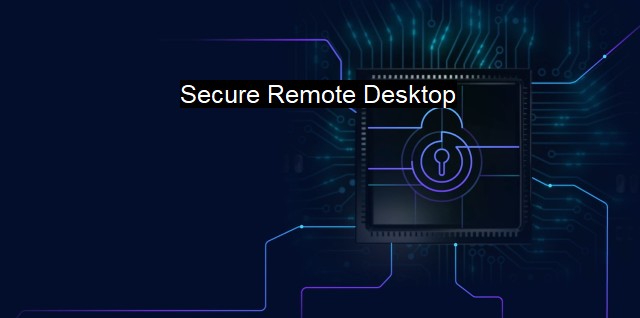What is Secure Remote Desktop?
Ensuring Safe and Secure Remote Desktop Access: Exploring Crucial Security Measures to Minimize Risks
The concept of "Secure Remote Desktop" holds immense significance. Often, organizations need to access and manage their systems and servers located in different parts of the world. This necessity brings into focus the utility of remote desktop connections, which are highly conducive to cross-border operations in our globalized world.A "secure remote desktop" would refer to a kind of setup which allows a user to access and control a computer in another location, exactly as if they were physically sitting in front of it. What sets this connection apart is its USP of security, safeguarding against possible malware intrusions and unauthorized access attempts.
This concept becomes increasingly essential when handling sensitive data or conducting critical operations, which our digitized systems often do. For instance, a system administrator sitting in an office in Tokyo can troubleshoot a technical issue on the server located in London, by establishing a secure remote desktop connection.
Setting up a secure remote desktop involves specific protocols for successful transmission of display outputs and keyboard/mouse inputs over the network. Usually, this includes RFB (Remote Framebuffer) or RDP (Remote Desktop Protocol), which handle secure connections and encryption, respectively.
Given our increasing reliance on Internet-based operations, cybersecurity becomes crucial in this setup. A remote desktop sans proper security could offer a gateway for hackers and malware, thereby compromising the security of the entire network. Thus, advanced encryption techniques, multi-factor authentication (MFA), and modern intrusion detection systems (IDS) are employed to ensure a secure remote desktop connection.
A critical aspect is the use of strong data encryption methods, such as TLS or VPN-based encryption, that encrypt data before leaving the system to make it indecipherable to attackers. If a cybercriminal were to intercept the data, all they would mention is unreadable data.
Installing an advanced antivirus software program is paramount in keeping the potentially harmful digital threats at bay. These programs add an extra layer of protection to your system by constantly scanning for viruses, trojans, and worms. Regular system updates ensure that the system gets protection from the latest threats.
Authentication too plays an essential role in establishing a secure remote desktop connection. Methods like two-factor authentication provide a secondary line of defense against unauthorized access. Even if the hacker acquires the user's login credentials, they still won't be able to access the system without the second factor.
Setting up firewalls can help control the connection attempts to the remote desktop. It provides an additional checks and balances system by monitoring and controlling incoming and outgoing network traffic on the premise of previously established security rules. Flagged connection attempts can thus be proactively terminated.
Maintaining audit logs is highly useful for identifying patterns related to security threats. They serve as a valuable reference for security investigations and trials, providing a clear trail of all operations to uncover potential vulnerabilities or lapses that may exist in the system's security.
The concept of a secure remote desktop is quintessential for businesses today. These connections have changed the face of business operations, cascading the growth of various types of businesses, from tech support companies to project managers overseeing teams around the world. With the right security measures put in place, such as using encryption, MFA, advanced antivirus protection, setting up correct user-access allowances and monitoring connections rigorously, secure remote desktops offer a streamlined and secure way to manage and control off-site servers and machines.

Secure Remote Desktop FAQs
What is a secure remote desktop?
A secure remote desktop is a tool that allows users to access their computer or network from a remote location over an encrypted connection to prevent unauthorized access, data breaches, and other cyber threats.How does a secure remote desktop work?
A secure remote desktop works by using encryption and authentication protocols to ensure that only authorized users can access the remote computer or network. The remote desktop software communicates with the remote computer and transfers data through an encrypted channel. This makes it difficult for attackers to intercept or steal sensitive information.What are some best practices for using a secure remote desktop?
Some best practices for using a secure remote desktop include regularly updating your software, using strong passwords and two-factor authentication, restricting access to authorized personnel, and monitoring and logging all remote activities to detect and respond to suspicious behavior.What are some of the risks associated with using a remote desktop?
Some of the risks associated with using a remote desktop include the possibility of unauthorized access, data breaches, malware infections, and other cyber attacks. Hackers can use remote desktop tools to bypass security measures, steal sensitive information, or install malicious software. To mitigate these risks, it is essential to use a secure remote desktop and implement other cybersecurity measures, such as antivirus software and firewalls.| | A | | | B | | | C | | | D | | | E | | | F | | | G | | | H | | | I | | | J | | | K | | | L | | | M | |
| | N | | | O | | | P | | | Q | | | R | | | S | | | T | | | U | | | V | | | W | | | X | | | Y | | | Z | |
| | 1 | | | 2 | | | 3 | | | 4 | | | 7 | | | 8 | | |||||||